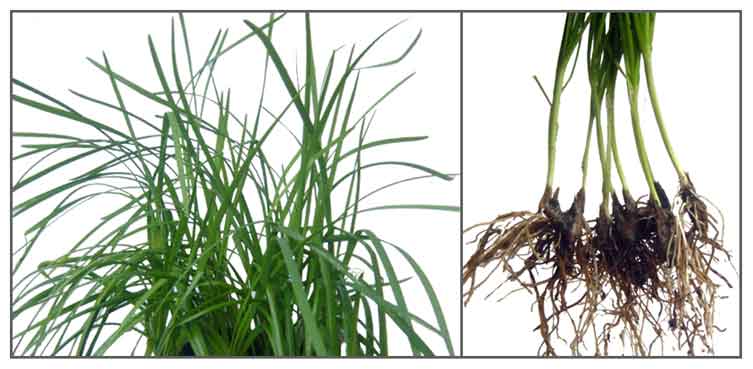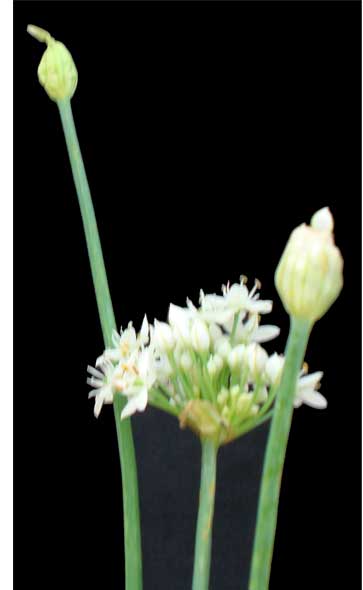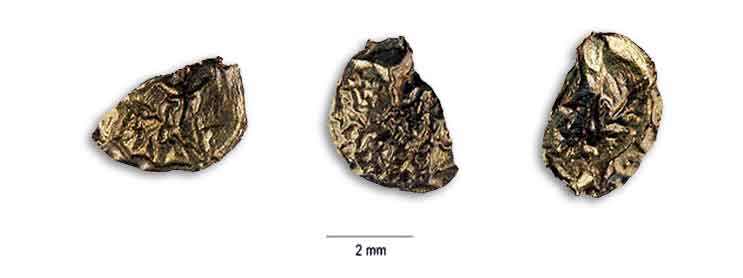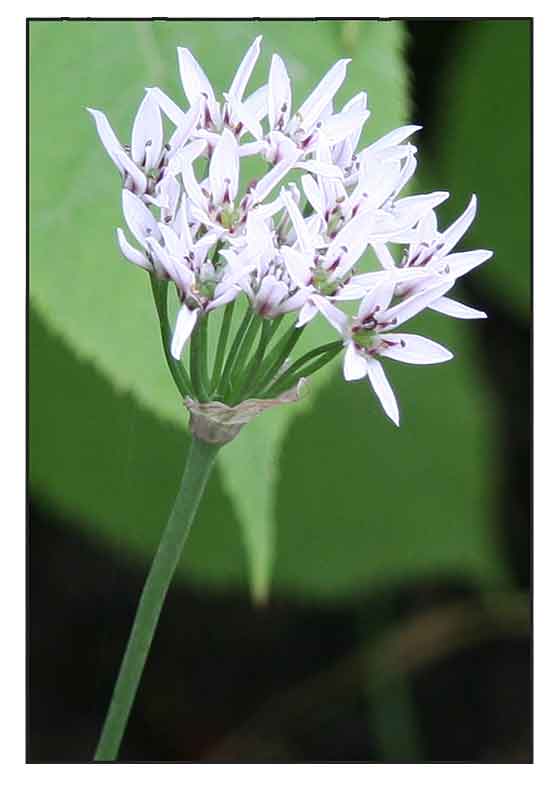| 
Gen info
- Alium ramosum (Chinese chinves) is a northern Asian species of wild onion.
Botany
Kuchai is a kind of leek, ranked-scented,
green, growing 20 to 40 centimeters high. Bulbs are small, white and clustered.
Leaves are green, grass-like, narrowly linear, flattish, 15 to 30 centimeters
long, 3 to 6 millimeters wide. Umbel has a few to many white flowers. The perianth
is bell-shaped. Fruits are on pedicels of 2 to 3 centimeters long, obovoid, 3-lobed,
5 to 7 millimeters in diameter. Seeds are black, depressed, globose or reniform,
2.5 to 3 millimeters in diameter. In the Philippines, the plant seldom flowers.
 Distribution Distribution
- Probably introduced in early times.
-
Cultivated in the Manila area by the
Chinese.
- Native to Altay, Amur, Buryatiya, China North-Central, Chita, Inner Mongolia, Irkutsk, Kazakhstan, Khabarovsk, Krasnoyarsk, Magadan, Manchuria, Mongolia, Primorye, Qinghai, Sakhalin, Tuva, West Siberia, Xinjiang, Yakutskiya. (8)
Constituents
- Vegetable ingredient is characterized by high protein and high carbohydrate and fructose. It has a high vitamin C content, 460±46 mg/100g; vitamin E, 3.3±0.96 mg/100g, and zinc, 8.87±0.55 mg/100g. (9)
-
Physiochemical composition of dry Allium odorum per in g/100 g: (1) dry matter 89.70±1.95; (2) fat, 0.60±0.06; total protein, 23.00±1.30; total carbohydrates, 56.25±2.60, minerals, 9.85±0.98, saccharose 5.6±0.23, glucose, 60.3±0.1; galactose, 5.8± 0.081, fructose 4.6±0.08, vitamin C 460.00±46.00 mg/100g, vitamin E 3.33±0.96 mg/100g. (9)
- Amino acid analysis yielded 30 free amino acids with a total concentration of 3124±1.43 mg/100g, with high concentrations of asparagine (572.2±0.08 mg/100g), glutamine (486.3±0.01 mg/100g), and alanine (250.9±0.03 mg/100g). (9)
- In analysis of fatty acid composition, palmitic acid was highest in concentration (30.55±0.01 g/100g. High concentrations were also recorded for tetracosenoic fatty acid. Polyunsaturated fatty acids yielded linoleic acid, linolenic acid, docosadienoic acid, and tetracosodienoic acid.
(9)
- Nutritive analysis of leaves yielded crude protein 17.006 ± 0.072%,
crude fat 2.133 ± 0.042 %, ash 1.567 ± 0.026 %, moisture 71.960 ± 0.115%, crude fiber 5.204 ± 0.005 %, total carbohydrate 7.344 ± 0.096 %, nutritive value 1166.933 ± 7.215 cal Kg. Elemental composition (mg/100g) yielded Ca 72.427 ± 0.455 mg, Mg 32.320 ± 0.640 mg, Mn 0.217 ± 0.027 mg, Ni 0.079 ± 0.028 mg, Cu 0.231 ± 0.012 mg, Zn 0.127 — 0.006 mg, Fe 1.072 ± 0.070 mg. (10)
- Phytochemical screening of water and ethanol extract yielded saponins, tannins, phenols, volatile oils, and amino acids; only the water extract yielded flavonoids. (11)
- Study of seeds isolated steroidal saponins, namely: protodioscin (1) and anguivioside A. (13)
- Study of methanol extract of seeds isolated a new furostane saponin, ramosaponin (1), and four known furostane saponins, protodioscin (2), dehydrotomatoside (3), (25 R)-26-O-(β-D-glucopyranosyl)-furost-5-ene-3β,22α,26-triol 3-O-β-D-glucopyranosyl-(1→4)-β-D-galactopyranoside (4), and anguivioside A (5).
(see study below) (14)
 Properties Properties
- Excellent source of calcium, phosphorus and iron.
-
Bulbs considered antiseptic and vulnerary.
-
Whole plant considered diuretic, digestive, carminative.
- Studies have suggested antioxidant, antifungal, antihypertensive properties.
 Parts utilized Parts utilized
- Leaves, bark, bulb, whole plant.
Uses
Edibility / Culinary
- Used like onion or
food flavoring spice.
- Leaves used in the preparation of Chinese dishes, and often cooked with liver.
- In Mongolia, used to season boiled mutton, or stuffed into dumplings.
Folkloric
• Externally, the fresh leaves
and bulbs are used as antiseptic and vulnerary.
• In Benguet, used for wounds, bruises, colds, and cough.
• Bark used for urinary tract infections by the Ifugao-migrants of the Sierra Madre.
• Leaves taken internally, act as a cordial.
• In Mongolia, used to treat stomach ailments.
• In Indo-Chiina,
whole plant used as a diuretic.
• In Manipur, used
for hemolytic anemia and insomnia.
• In Peru, used for bronchitis and asthma: fresh, whole plant diced, boiled with sugar and ginger until thick, and taken a spoonful every six hours for one week.
• An ingredient of a herbal formulation (Allium odorum, Allium sativum, Tinospora cordifolia, Adhatoda vasica and Tridax procumbens) to treat coccidiosis.
Studies
• Antioxidant: Study
showed part of the Allium family possess antioxidant capability. Heat
treatments reduced the antioxidant activity for most foods. (1)
• Antifungal: Study
of extracts of 7 Allium plants, including Chinese chive, were examined for antifungal activity against three Aspergillus species: A niger, A flavus and A fumigatus. All the plants possessed antifungal activity, the inhibitory activity decreased with increasing incubation and heating temperature. Acetic acid plus heat treatment of the extracts resulted in greater inhibition. (2)
• Hypotensive / Antihypertensive: Study
of ethanol extract of Chinese chives (Allium odorum) showed hypotensive and antihypertensive effect. (3)
• Antibacterial: Study evaluated the phytochemical constituents and antibacterial properties of aqueous and ethanol extracts of Z. armatum, E. foetidum, and Allium odorum. Antimicrobial activity was tested against two gram positive bacteria (Staphylococcus aureus and Bacillus cereus) and two gram negative bacteria (Klebsiella pneumonia and Pseudomonas aeruginosa). Allium odorum was next to Z. armatum in antibacterial activity. (see constituents above) (11)
• Ramosaponin / Lipid Accumulation Inhibitory Activity / Seeds: Study of methanol extract of seeds isolated a new furostane saponin, ramosaponin (1), and four known furostane saponins, protodioscin (2), dehydrotomatoside (3), (25 R)-26-O-(β-D-glucopyranosyl)-furost-5-ene-3β,22α,26-triol 3-O-β-D-glucopyranosyl-(1→4)-β-D-galactopyranoside (4), and anguivioside A (5). All compounds were evaluated for reduction of lipid accumulation in HepG2 cell line. Compound 1 showed significant lipid accumulation inhibitory activity with IC50 of 64.32 µM. (14)Â
Availability
Cultivated.
Extracts and seeds in the cybermarket.
|

![]()

